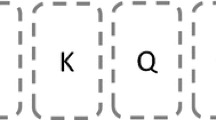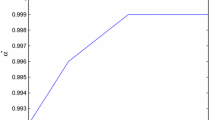Abstract
This paper examines the risk taking behavior of a banking firm facing ambiguity and possessing smooth ambiguity preferences. Ambiguity is modeled by a second-order probability distribution that captures the bank’s uncertainty about which of the subjective beliefs govern the return on its loans. Ambiguity aversion is modeled by a concave transformation of the (first-order) expected utility of profit conditional on each plausible subjective distribution of the random loan return. Within this framework, we show that the bank finds it less attractive to take risk in the presence than in the absence of ambiguity. This result extends to the case of greater ambiguity aversion. Given that the bank’s smooth ambiguity preferences exhibit non-increasing absolute ambiguity aversion, imposing a more stringent capital requirement to the bank has the desired effect that limits the bank’s incentive to take on excessive risk.
Similar content being viewed by others
Notes
See also, for example, Broll (2016a).
Throughout the paper, random variables have a tilde \((^{\sim })\) while their realizations do not.
This assumption is motivated by the premise that the behavior of an ambiguity-neutral decision maker should be unaffected by the introduction of, or changes in, ambiguity.
For any two random variables, \(\tilde{X}\) and \(\tilde{Y}\), we have \(\mathrm{Cov}(\tilde{X},\tilde{Y})=\mathrm{E}(\tilde{X}\tilde{Y}) -\mathrm{E}(\tilde{X})\mathrm{E}(\tilde{Y})\).
References
Alary, D., Gollier, C., & Treich, N. (2013). The effect of ambiguity aversion on insurance and self-production. Economic Journal, 123, 1188–1202.
Broll, U., Welzel, P., & Wong, K. P. (2016a). The banking firm under ambiguity aversion. CEPIE Working Paper No. 01/16, Center of Public and International Economics, Dresden.
Broll, U., Welzel, P., & Wong, K. P. (2016b). Expectation dependence: The banking firm under risk. Applied Mathematics Research Express, 2016(2), 281–288.
Caballero, R. J., & Krishnamurthy, A. (2008). Collective risk management in a flight to quality episode. Journal of Finance, 63, 2195–2230.
Freixas, X., & Rochet, J.-C. (2008). Microeconomics of banking (2nd ed.). Cambridge, MA: MIT Press.
Gilboa, I., & Schmeidler, D. (1989). Maxmin expected utility with non-unique prior. Journal of Mathematical Economics, 18, 141–153.
Gollier, C. (2011). Portfolio choices and asset prices: The comparative statics of ambiguity aversion. Review of Economic Studies, 78, 1329–1344.
Ivashina, V., & Scharfstein, D. (2010). Bank lending during the financial crisis of 2008. Journal of Financial Economics, 97, 319–338.
Klibanoff, P., Marinacci, M., & Mukerji, S. (2005). A smooth model of decision making under ambiguity. Econometrica, 73, 1849–1892.
Snow, A. (2010). Ambiguity and the value of information. Journal of Risk and Uncertainty, 40, 133–145.
Snow, A. (2011). Ambiguity aversion and the propensities for self-insurance and self-protection. Journal of Risk and Uncertainty, 42, 27–43.
Taboga, M. (2005). Portfolio selection with two-stage preferences. Finance Research Letters, 2, 152–164.
Wong, K. P. (1997). On the determinants of bank interest margins under credit and interest rate risk. Journal of Banking and Finance, 21, 251–271.
Wong, K. P. (2015a). A smooth ambiguity model of the competitive firm. Bulletin of Economic Research, 67, 97–110.
Wong, K. P. (2015b). Ambiguity and the value of hedging. Journal of Futures Markets, 35, 839–848.
Wong, K. P. (2016a). Ambiguity and the multinational firm. International Review of Economics & Finance, 43, 404–414.
Wong, K. P. (2016b). Production and hedging under smooth ambiguity preferences. Journal of Futures Markets, 36, 506–518.
Wong, K. P. (2017). Cross-hedging ambiguous exchange rate risk. Journal of Futures Markets, 37, 132–147.
Acknowledgements
We would like to thank both of our anonymous referees and the editor of this Journal for helpful comments and suggestions. In memory to Harris Schlesinger.
Author information
Authors and Affiliations
Corresponding author
Appendix
Appendix
Proof of Proposition 2
Given that \(R'(\theta )\ge (\le ) \ 0\) for all \(\theta \in [\underline{\theta },\overline{\theta }],\) it follows from Eq. (10) that there exists a point, \(\theta ^*\in (\underline{\theta },\overline{\theta }),\) at which \(R(\theta ^*)=R_C+C'(L^*).\) Note that
which is negative (positive) given that \(R'(\theta )\ge (\le ) \ 0\) for all \(\theta \in [\underline{\theta },\overline{\theta }]\) and \(K''(\cdot )<0.\) Using Eq. (10), we have
where the inequality follows from \(R'(\theta )\ge (\le ) \ 0\) for all \(\theta \in [\underline{\theta },\overline{\theta }]\) and Eq. (21). From Eq. (10), the right-hand side of Eq. (10) is negative so that \(L^{\dagger }<L^{*}\). \(\Box\)
For intuition we use Eq. (16) to compare the ambiguity premium under \(\phi (U)\) and that under \(K\Big (\phi (U)\Big )\), both of which are evaluated at \(L=L^*\):
with \(\Delta ^* = R(\tilde{\theta })-R_C-C'(L^*)\) where we have used Eq. (10). It follows from Eq. (10) that the covariance term on the right-hand side of Eq. (24) is negative given that \(R(\theta )\) is monotonic in \(\theta\). In this case, the ambiguity premium is more negative under \(K\Big (\phi (U)\Big )\) than under \(\phi (U)\). Greater ambiguity aversion as such reduces the certainty equivalent marginal revenue of loans. \(\square\)
Proof of Proposition 3
Consider the function:
Given that \(R'(\theta )\ge (\le ) \ 0\) for all \(\theta \in [\underline{\theta },\overline{\theta }]\), it follows from Eq. (10) that there exists a point, \(\theta ^*\in (\underline{\theta },\overline{\theta })\), at which \(R(\theta ^*)=R_C+C'(L^*)\). Since \(-\phi ''(U)/\phi '(U)\) is a non-increasing function of U, Eq. (25) implies that \(\Phi '(\theta )\le (\ge ) \ 0\) for all \(\theta \in [\underline{\theta },\overline{\theta }]\) given that \(R'(\theta )\ge (\le ) \ 0\) for all \(\theta \in [\underline{\theta },\overline{\theta }]\). Using Eq. (10), we have
It then follows from Eq. (10) that the second term on the right-hand side of Eq. (20) is negative so that \(\mathrm{d}L^{*}/\mathrm{d}\alpha <0\). \(\square\)
Rights and permissions
About this article
Cite this article
Broll, U., Welzel, P. & Wong, K.P. Ambiguity preferences, risk taking and the banking firm. Eurasian Econ Rev 8, 343–353 (2018). https://doi.org/10.1007/s40822-018-0096-2
Received:
Revised:
Accepted:
Published:
Issue Date:
DOI: https://doi.org/10.1007/s40822-018-0096-2




